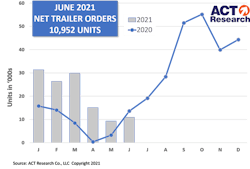Truck dealers’ used Class 8 volumes were 1% lower month-over-month in June–and 5% lower compared to this time last year, according to the latest data compiled by ACT Research in its State of the Industry: U.S. Classes 3-8 Used Trucks report. With lower volumes, average used truck prices are on the rise.
“Indicators we track for the economy, for freight, and for equipment utilization are about as good as we have ever seen, but recent data flows from the last six weeks or so suggest that the near-continuous upward sweep of activity over the last few quarters may be beginning to level,” said Kenny Vieth, ACT’s president and senior analyst. “To be clear: we are not forecasting a rollercoaster descent from the top. Indeed, all you have to do is look at our forecast for the next two years – modest expansion, and basically sustained freight volumes at historically high levels.”
While used heavy-duty truck volumes are down a bit compared to this year and last year’s mid-year tallies, volumes are up 20% year to date, according to ACT data.
“Used Class 8 same dealer sales continued to face challenges in June, though they nearly reached parity with May, slipping just 1%,” said Steve Tam, vice president at ACT Research. “Sales typically increase about nine percentage points from May to June, so they moved counter to expectations, sometimes a precursor signaling impending change. Additionally, anecdotes suggest used truck inventory continued to contract in June, increasing pressure on both sales and pricing.”
Average prices for used equipment in June were 5% higher compared to May and 51% more expensive than in June 2020, while average miles were 5% lower both month-over-month and year-over-year, according to ACT. The average equipment age was unchanged from May but down 3% compared to June 2020.
“Discussions we have had with dealers during the past month have centered on price and availability,” Tam said. “Circumstances are forcing dealers and buyers to pay not only way more than normal for trucks but way more than they want to pay. While we do not know when the market will turn, we note that underlying fundamentals suggest that the market transition will be more orderly, absent the popping of any bubbles like in some previous cycles.”
The report from ACT provides data on the average selling price, miles, and age based on a sample of industry data. In addition, the report provides the average selling price for top-selling Class 8 models for each of the major truck OEMs: Freightliner (Daimler); Kenworth and Peterbilt (Paccar); International (Navistar); and Volvo and Mack (Volvo).
Looking at the different sales channels for used Class 8 vehicles, Tam added: “Channel results remained mixed in June, with the auction segment declining in all three time periods. Conversely, the retail markets showed improvement for all comparisons. Wholesale transactions improved in the short term, but were weaker longer term.”
Trailer orders up
June net trailer orders in the U.S. totaled 10,952, an 18% increase from the previous month, but almost 20% lower compared to June 2020, according to ACT. Before accounting for cancellations, new orders of about 13,100 units were up more than 7% versus May, but down 19% from the previous June, according to ACT Research’s State of the Industry: U.S. Trailer Report.
“Despite sequential improvement, net orders continue to be diminished by a ‘pause’ in order acceptance at several OEMs. However, that pause was not universal, as reefers surged 90% from a very lackluster May,” said Frank Maly, director of CV transportation analysis and research at ACT. “Without that support, total industry volume could easily have posted a net order decline to close the quarter. The industry also posted the first year-over-year decline in net orders since May of 2020, the end of the COVID-induced order retrenchment last year.”
“The ratio of trailer orders to truck orders, shown in the graph, is an indicator of the degree of impact the order pause is generating,” May added. “Normally ranging around 1.5, the trailer/tractor net order ratio started Q2 just below 1.0 and plummeted to approximately 0.65 at quarter’s end.” He concluded, “This is an indication of pent-up demand that likely will be quickly addressed when order boards officially open for 2022.”
ACT Research’s State of the Industry: U.S. Trailers report provides a monthly review of the current US trailer market statistics, as well as trailer OEM build plans and market indicators divided by all major trailer types, including backlogs, build, inventory, new orders, cancellations, net orders, and factory shipments.
“What we are saying is that the upward push of the heavy-duty market is in transition, from expansion to stability at high levels, Vieth said. "The rate of change will get close to zero. Said another way, the market should bump along at a peak that over time should become a high plateau.”
About the Author
FleetOwner Staff
Our Editorial Team
Kevin Jones, Editorial Director, Commercial Vehicle Group
Josh Fisher, Editor-in-Chief
Jade Brasher, Senior Editor
Jeremy Wolfe, Editor
Jenna Hume, Digital Editor
Eric Van Egeren, Art Director


